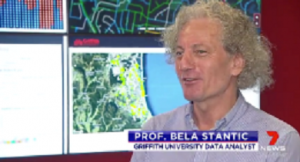On the morning of the 2019 federal election, Professor BelaStanticbreathed a sigh of relief as the results of his analysis hit mainstream media, via an exclusive article for news.com.au.
Not wanting to influence the outcome, the Griffith Head of School for Information and Communication Technology delayed his prediction with News Corp’s online flagship until midday on election day, when he revealed his belief that Scott Morrison would be returned to the top job, despite official polls saying otherwise.
What followed was a frenzy of media appearances, as news outlets clamoured to hear from the only expert to correctly predict the outcome.
“I’ve worked in data analytics for a long time because of my strong mathematicaland data sciencebackground – it’s what I enjoy doing. I’m not good with names, but I’m very good with numbers.”
So, who is ProfessorStantic?

As Head of School and the Director of Big Data and Smart Analytics lab within the Institutefor Integrated and Intelligent Systems,ProfStantichas long been Griffith’s proponent for the power of big data in analysing major event outcomes.
Attention from media as well as both national and international organisationshasincreasingly come his way after he correctly predicted 49 of the 50 states won by the Republicans in the 2016 US election, which ultimately brought President Donald Trump to power.
At the time of his forecast, Democrat Hilary Clinton was still expected to win the presidency.
That same year, the vote to leave the European Union after the Brexit Referendum was alsoprophesisedby ProfStantic.
These predictions were not made with a cursory glance at polls and random social media threads — they were formulated after days of crunchingmillions of Tweets, that not onlyanalysedthe figures broadly but also the underlyingtargets andsentiment within each one.
An interest in astrophysics and a fondness for beach running close to his Gold Coast home allows ProfStanticsome downtime away from the big data game, but he admits numbers are never far from his mind.
“Even as a child, Irealisedthat I read numbers differently than others and I am able toeasilyfind interesting and often hidden information.
“Later, thanks to data science and immense power of computing, I could finally lift it to unimaginable level.”
How does he do it?
Between PhD supervisions, day-to-day meetings, and the calls and emails and that fall into his academic remit, ProfStanticis bound to be crunching the numbers from his office at Griffith’s Gold Coast campus.
Just one Tweet being worked on by one of his specially crafted algorithms can encompass an entire screen and resemble a tangle of numbers that slowly tick over.
“Twitter is public,very dynamic,and alsohas a vast volume of posts – that’s why it’s useful for predictions. 
“But there are other social media platforms that can also be useful to gain insight into different areas and identify valuable information, which I am alsoharnessingina number offunded projects in the Big Data and Smart Analytics lab at Griffith University.
“It can be a lengthycomputing intensiveprocess. In the last few days before Australia’s 2019 election I overheated myBig Data cluster — all the CPUs were working atalmost100%.
“My algorithms work in a similar logic to the human brain for reasoning. That’s how I’ve created themin order toanalyseand sift data that reflects evolving sentiments.”
What is the future of big data in predictions?
Businesses are starting torealisethe power of Big data analytics and many of them are venturing into it – some with more success, others with less.
ProfStanticbelieves the reason for the slow uptake so far was resistance and the difficulty in “breaking some barriers”; another reason is lack ofdata scientists.
He believes the work he is doing at Griffith, coupled with the media attention and calls for advice from international governments and other externalorganisationsthat accompany his predictions, are helping thisrealisationto occur faster.
“Anything can be predicted if there is sufficient data. The issue is that prediction caninfluence output andsome thingsmade publictoo earlycan causethe result to change.
“Predicting electionsI don’tsee as achallengeany more,but I’m now focusing on fakeposts and fakenews, to identify where people aren’t telling the truth in their posts. It’s my lie detector for social media.”
Griffith Sciences IMPACT event
Prof BelaStanticwill presentBig Data: It was not a Miracle, it was Mathematical Certainty, on Tuesday, June 18, at the QCA Lecture Theatre and Gallery Building, South Bank campus, Griffith University, 5.30-8pm. Please register via the link.
